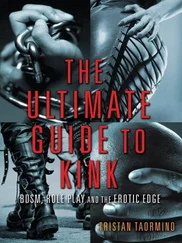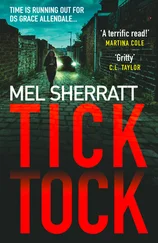Despite its wholesome image, the Wandervogel movement could not avoid the stigma of male-to-male sex and gay seduction. In fact, the original organization nearly expired when one of its adult chaperones was accused of being a supporter of Der Eigene’ s Militant Homosexualist philosophy. The counselor quickly resigned and some all-female units of Wandervogel were hastily assembled but neither action really cooled the sexually-charged atmosphere. The entire Wandervogel experience, according to the autobiographies of its precocious founders, was shot through with homoerotic tension.
Even more obviously gay were the Wild-Boys , teenaged members of anti-social gangs that lived in the outlying districts of Berlin. Working in groups of six or eight, these 14- to 18-year-old runaways established Peter Pan-like encampments in park sites, warehouses, and abandoned apartments. Led by punkish-dressed chieftains called “Bulls,” each Wild-Boy association had its own elaborate blood-oaths and ceremonies of ritualized sex.
Typically, a young initiate would forced to box (or knife-fight) with the toughest member of the crew, be gang-raped while bound and gagged, ordered to masturbate publicly and then ejaculate on command, or act as a living commode for his drunken associates. Some newly-inducted boys were chosen by the Bulls as their “queens” or designated shared “girlfriends” for the pack. Most Wild-Boys sported pirate-style earrings and garish tattoos. While the majority of gangs flaunted their ragtag, hobo garb, others paraded around in distinctive group costumes, like top hats and shabby tuxedoes, American trapper outfits, college graduates in mortar-boards, or paper buffalo heads. The gang names alone testified to the influence of Karl May’s North American frontier novels and other staples of German pulp fiction: “Fear No Death,” “Indian Blood,” “The Forest Pirates,” “Wild West,” “Girl-Shy,” “Santa Fe,” “Gypsy Love,” “The Dirty Boys,” “Red Apaches.”
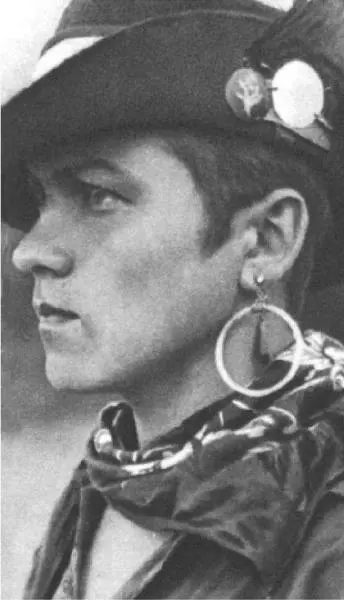
Winnetou’s Queen
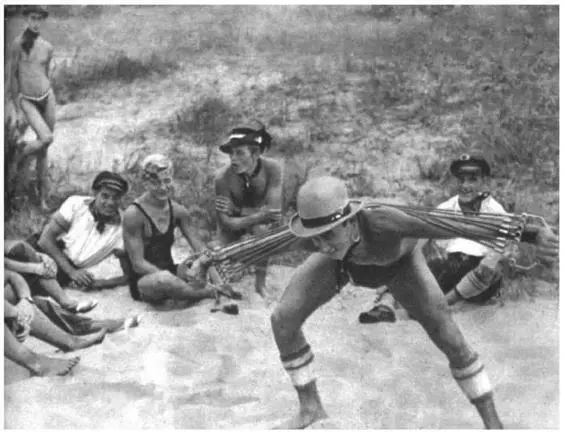
Wild and Free’s Test of Strength, 1932
The Wild-Boys subsisted through a host of criminal enterprises, mostly cat burglary, smash-and-grab robberies, car theft, and unglamorous forms of boy prostitution. Boosts (unscrupulous proprietors of low dives) procured the services of the prettiest and youngest of gangs for Sucker-Lickers seeking passive Kitty-Receivers . Other 14- and 15-year-olds were sent out independently by the Bulls for a Bummel on the Alex Kietz . Although sometimes confused with eccentric Wandervogel groups by the Polenta , the authentic Wild-Boys —200 crews in Berlin North alone—fell seamlessly into the city’s notorious gay demi-monde.
Daniel Guérin, a French gay anarchist, visited a Wild-Boy outing near Berlin’s Lake Lehnitz in September 1932. There he interviewed Winnetou, the group’s Bull, and recorded Wild-Free’s campfire pastimes and initiation rites ( Vu , “A Return to Barbarism,” March 8, 1933). Winnetou gamely explained to the foreign journalist his sado-sexual ethos: occasionally, naked newcomers were tied to the tops of trees and violated with phallic-looking sticks; other times the would-be nomads were gangbanged on Stoszsofas , or fuck couches.
Remarkably, the sociopathic Winnetou showed up on a Berlin thoroughfare one year after the Vu tête-à-tête. Then he had the familiar bearings of a menacing Nazi tough. Winnetou, however, recognized one of Guérin’s left-wing colleagues and greeted her warmly as his old happy-go-lucky, Wild-Boy self.
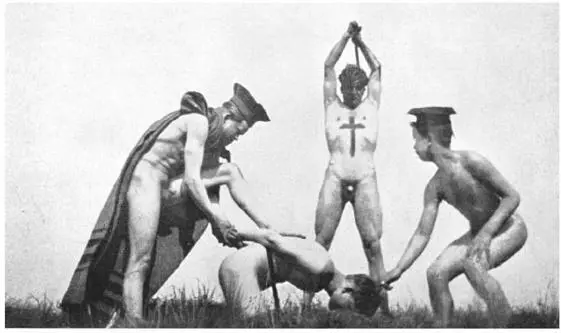
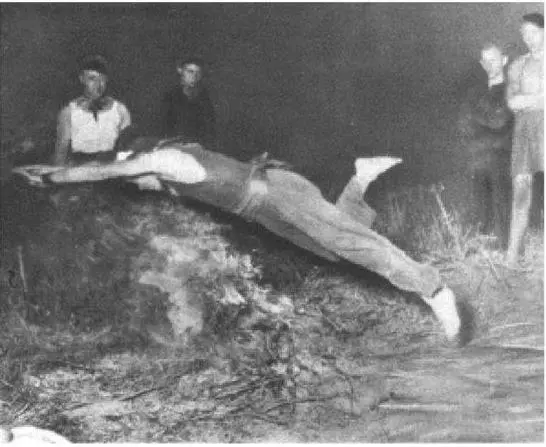
Wild-Boy sexual initiation
The enormous volume of sex-traffic in boys and very young men differentiated Berlin from all previous centers of debauchery and “decadent” tourism. Nearly every Western metropolis in the interwar period, naturally, had a substantial number of clandestine homosexual bars and backstreet arenas where gay men could secure the ministrations of male prostitutes. Hamburg, in 1930 for example, claimed the second greatest concentration of Line-Boys in Europe at 5,000 strong and growing. But Berlin, the acknowledged leader then, had at least seven times that many; a figure which, according to the calculations of its vice commissioners, was also growing by the month.
Christopher Isherwood wasn’t exaggerating when he wrote, “Berlin meant boys.”
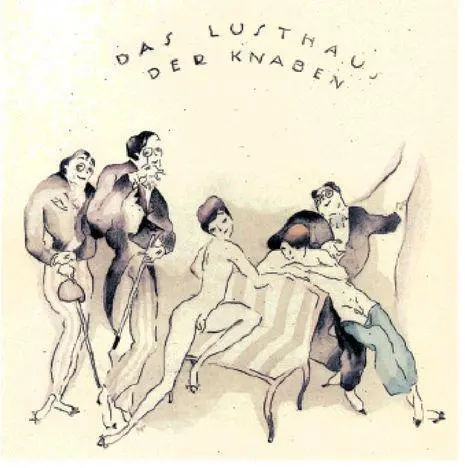
Guy de Laurence, The Lust House of Boys , 1922
Most foreigners attributed the spread of male prostitution to the Republic’s fiscal malaise and political failure to stem the plummeting employment rate among Germany’s unskilled laborers. The congested corners of rowdy Wild-Boys , Bubes (or “Butchers”), Line-Boys , and Doll-Boys in the Friedrichstadt, to them, was only one appalling symptom of the national moral collapse. Others saw a link to Berlin’s female prostitution problem: young whores were constantly introducing their junior male siblings into the lurid profession. While both theories contained a bit of dismal truth, municipal statistics, in general, supported neither the economic nor the corrupt familial arguments. Male prostitution in Berlin continued to swell for a simpler market reason: the demand for it increased.
Beginning at nine in the morning, hundreds of Line-Boys were already on the Strich as they waited in and around the public lavatories of the city’s luxury hotels. British businessmen were the early morning targets; shy American tourists in the afternoon, followed by stingy German provincials before evening hours. By dark, Berlin’s homosexual Kietz was in full swing. The Tiergarten, the Alex, and the Linden-Passage were first destinations of Suitors seeking Doll-Boys (under 14) or run-of-the-mill Line-Boys . In Berlin South, slightly more mature Wild-Boys and Bubes were available at gay pick-up Dielen .
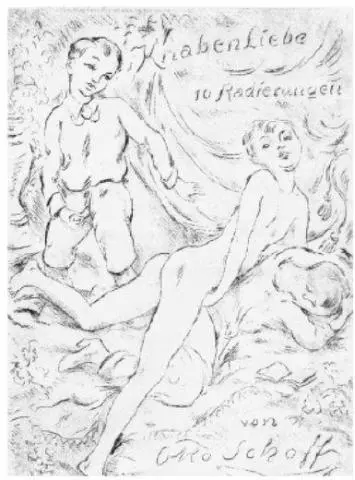
Schoff, Boy’s Love
The only quarter identified with adult homosexual trade was in the West. There, an unknown number of “Massage Parlors”—around two dozen repeatedly advertised in gay publications—featured erotic specialties. Like their sister straight houses to the east and south, the queer Parlors offered sessions in B&D, flagellation, and costumed roleplay but with a much greater emphasis on scatological scenes. While adding variety to the local color, they certainly never amounted to more than five or ten percent of Berlin’s wholesale trafficking in male flesh.
Gay Dielen and Entertainment
The heart of Berlin’s indigenous gay life was its Dielen and bars. The exact number of these varied from guidebook to guidebook. The commonly cited figure was 65 or 80. But if one included restaurant backrooms, unlicensed Kaschemmen (criminal dives), and lounges that accommodated separate gay, lesbian, straight, and/or transvestite patrons, the sum easily doubled.
Читать дальше









